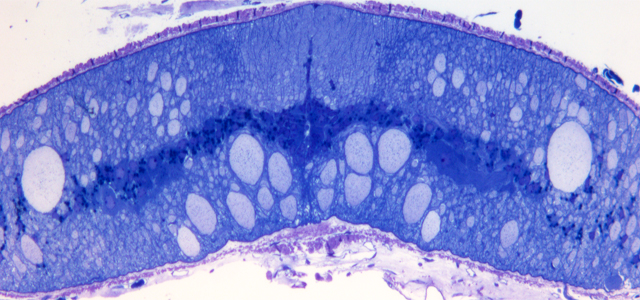MBL Scientists Identify Drug that Improves Neuronal Survival after Spinal Cord Injury in Lamprey

Spinal cord injury (SCI) in humans typically has a poor prognosis, including permanent losses in mobility and sensation, reflecting in part our very limited capacity for neural regeneration.
To understand these limits on recovery after SCI, MBL Associate Scientist Jennifer Morgan studies the lamprey, a fish that can spontaneously regenerate neurons after SCI and regain mobility remarkably well.
Morgan’s team recently discovered that one risk factor for neural death after SCI is the accumulation of a protein, synuclein, in the damaged neurons. Together with their collaborators, Morgan’s team also identified a drug, CLR01, that reduces the accumulation of synuclein in lamprey neurons after SCI, and thereby improves their survival. They published their study this week in Experimental Neurology.
 Cross-section of an uninjured lamprey spinal cord. Credit: Paul Oliphint and Jennifer Morgan
Cross-section of an uninjured lamprey spinal cord. Credit: Paul Oliphint and Jennifer Morgan“Synuclein is an interesting protein to study because its aggregation has been linked to Parkinson’s disease and several other major neurodegenerative disorders,” Morgan says. “We were therefore surprised to see synuclein accumulate in neurons in the context of injury. This prompts us to further explore the mechanisms underlying injury-induced neurodegeneration and possible parallels between injury and disease states.”
"Starting from the vantage point of regenerative biology, these studies demonstrate the tremendous value of marine organisms as novel models for exploring the biology of neurodegenerative diseases,” says Jonathan Gitlin, director of the MBL’s Eugene Bell Center for Regenerative Biology and Tissue Engineering.
Citation:
Fogerson SM, et al (2016) Reducing synuclein accumulation improves neuronal survival after spinal cord injury. Exp Neurol. doi: 10.1016/j.expneurol.2016.02.004